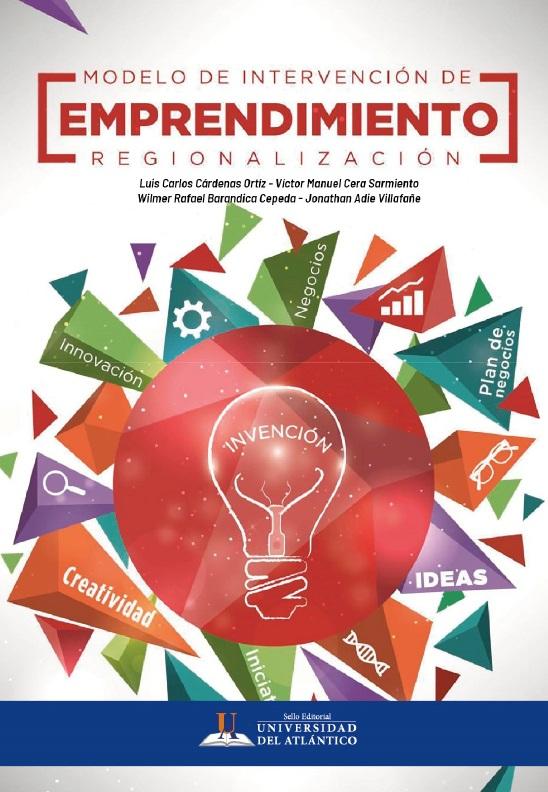Entrepreneurship intervention model: Regionalization
Keywords:
Entrepreneurship intervention model, RegionalizationSynopsis
The present book Entrepreneurship intervention model. Regionalization is the product of a research process carried out in different high impact companies in the Colombian Caribbean region. The book highlights a whole process of investigation and study of the productive sector of companies and how they generate development in the young people of the Atlantic, projecting them as entrepreneurs and managers of micro-companies. For the above, the investigative component was used, using the descriptive type of research, with quantitative variables, validating the hypothesis, and the descriptive transectional design, aiming to investigate tools and techniques for the development of systemic entrepreneurship, which impact on a specific region. The results of the study yielded variables that made it possible for the investigating authors to create an intervention model that allows young people in the Caribbean region to project themselves as entrepreneurs and managers of micro-businesses.
Downloads
References
Aguilar, C. (1980). La creatividad y el proceso creativo. México: Ed. Edamex.
Amabile, T. M. (1988). A model of creativity and innovation in organization. In B. M. Staw & L. L. Cummings (eds.), Research in Organizational Behaviour, 10, 123-167.
Arieti, S. (1993). La creatividad. México: FCE
Audretsch, B., Keilbach, C. & Lehmann, E. (2006). Entrepreneurship and economic growth. Oxford: Oxford University Press.
Bacus, A. y Romain, C. (1992). Creatividad. Como desarrollarla. Barcelona: Iberia.
Cohendet, P. & Grandadam, D. (2008). Individuals, communities and firms in the creative process. Dime Scientific Conference, W.P. 1.1 Parallel Session on Communities and Incentives for Knowledge Creation, Mars.
Craft, A. (2005). Creativity in schools: Tensions and dilemmas. Abingdon: RoutledgeFalmer.
Craft, A. (2006). Creativity and Wisdom. Cambridge Journal of Education, 36(3), 336-350.
Craft, A. (2008). Trusteeship, wisdom and the creative future of education. UNESCO observatory, E-Journal, 1(3), Special Issue: Creativity, policy and practice discourses: productive tensions in the new millennium.
Cropley, A. J. (1999). La Creatividad y la Cognición: Producir novedad efectiva. Roeper Review, 21(4), 253-261.
De La Torre, S. (1982). Educar en la creatividad. España: Ed. Narcea.
De La Torre, S. (1999). Creatividad y formación. México: Editorial Trillas.
De Pardo, D. (1981). La Creatividad Instrumento de Diagnóstico e Innovación. En Creatividad y educación (pp.249-261). Madrid: MEC.
De Prado, D. (2011). La solución creativa de problemas. Santiago de Compostela: Editorial Tórculo Artes Gráficas.
European Commission (1998). Innovation Management Techniques in Operation. European Commission, DG XIII, Luxemburgo.
Fayolle, A. (2004). Entrepreneuriat, apprendre à entreprendre. Paris: Dunod.
Formichella, M. (2004). El concepto de emprendimiento y su relación con la educación, el empleo y el desarrollo local. Buenos Aires: Publicación Inta.
Foster, J. (2003). Cómo Generar ideas. Madrid, España: Editorial Universitaria Ramón Areces.
Fouchécour, I., Clause, P. & Renard, Nathalie. (2012). Cultiva tu creatividad, Cuaderno de prácticas. Barcelona: Terapias Verdes, S. L.
GEM Colombia. (2007). Estudio de la actividad empresarial en 2007. Bogotá, Colombia. Obtenido de https://colaboracion.dnp.gov.co/CDT/Desarrollo%20Empresarial/GEM%20Colombia%202007.pdf
Harrington, J., Hoffherr, G. y Reid, R. (1999). Herramientas para la creatividad. Colombia: McGraw-Hill.
Hennessey, B. & Amabile, T. (2010). Creativity. The Annual review of Psychology, 10(1), 342-365.
Hernández-Sampieri, R., Fernández, C. & Baptista, P. (2014). Metodología de la investigación (Sexta ed.). México D.F: McGraw-Hill. Obtenido de http://observatorio.epacartagena.gov.co/wp-content/uploads/2017/08/metodologia-de-la-investigacion-sexta-edicion.compressed.pdf
Kahl, C. H., Da Fonseca, L. H. & Witte, E. H. (2009). Revisiting Creativity Research: An Investigation of Contemporary Approaches. Creativity Research Journal, 21(1), 1-5.
Lasswell, H. (1979). Estructura y función de la comunicación en la sociedad. En: De Moragas, Miguel. Sociología de la comunicación de masas. Barcelona: Gili.
Lewis, D., Greene, J. & Roca, M. (1989). Arte De Pensar. Editorial Maritnes Roca.
Ley 1014. (26 de 2006). De fomento a la cultura del emprendimiento. Congreso de la República. Bogotá, Colombia. Obtenido de http://www.secretariasenado.gov.co/senado/basedoc/ley_1014_2006.html
López, A. (2007). The global competitiveness report 2007- 2008 (pp.3-50). M. E. Porter, K. Schwab, & X. Sala-i-Martin (Eds.). London, UK: Palgrave Macmillan.
Majaro, S. (1992). “Cómo Generar Ideas para Generar Beneficios”. Argentina: Ediciones Granica.
Maurya, A. (2012). Running Lean: Iterate From Plan A to a Plan that Works. United States: O’Reilly Series Editor.
Morris, C. G. & Maisto A. (2005). Introducción a la Psicologia. Pearson Educación.
OECD & EUROSTAT (2005). Oslo Manual: Guidelines for Collecting and Interpreting Innovation Data, 3ª ed., Paris Cedex 16: OECD Publications.
Onti Roca, F. (2001). La empresa creativa: metodologías para el desarrollo de la innovación en las organizaciones. Barcelona: Granica (EADA Gestión).
Osborne, A. (1953). Applied Imagination. USA: Charles Scribner.
Osborne, A. F. (1963). Applied Imagination: Principles and Procedures of Creative Thinking. 3rd ed., New York: Scribner.
Osterwalder, A. & Pigneur, Y. (2009). Business Model Generation. Amsterdam: Edición Privada.
Osterwalder, A. (2004). The Business Model Ontology: a Proposition in a Design Science Approach. Disertación doctoral. Lausana: École des Hautes Études Comerciales de l’Université de Lausanne.
Osterwalder, A. (2007). How to describe and improve your Business Model to Compete Better (Draft version v.0.8 beta). Melbourne: La Trobe University.
Osterwalder, A. (2008). Business Model Innovation Blog spot.www.businessmodelinnovation.blogspot
Osterwalder, A. (2009). Hub (Blog) for Co-create the Book Business Model Generation. http://www.businessmodelhub.com
Penagos, J. C. (1997). El Origen de la Creatividad. Calidad y Excelencia, 2(13), 4-8.
Piaget, J. (1964). Seis Estudios de Psicologia. Barcelona: Editorial Labor S.A
Sawyer, R. K. (2006). Educating for innovation. Thinking Skills and Creativity, 1(1) 41-48.
Schnarch Kirber, A. (2008). Creatividad Aplicada. Bogota D.C: ECOE Ediciones.
Silva, J. (2013). Emprendedor; Hacia un emprendimiento sostenible. Segunda Edición. Bogota D.C.: Editorial Alfaomega.
Tarapuez, E. & Lima, C. (2008). Creatividad Empresarial. Colombia: Eco Ediciones.
Tennent, J. & Friend G. (2008). Como delinear un modelo de negocios. Buenos Aires: The Economist.
Vianna, M., Vianna Y., Adler I., Lucena B. & Russo, B. (2012). Design Thinking. Rio de Janeiro: MJV Express.
Weisberg, R. (1986). Creatividad: Genio y otros mitos. Nueva York: Freeman
Weisberg, R. (1987). Creatividad. Barcelona: Labor..








